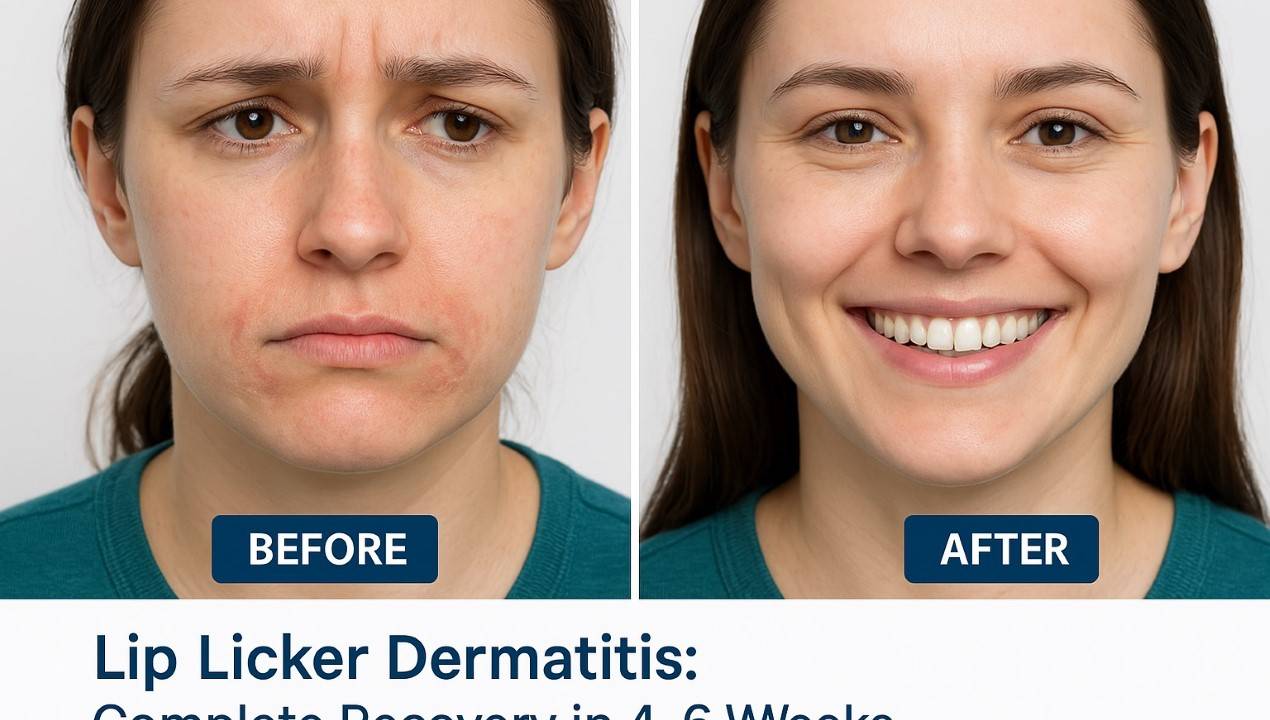Lip licker dermatitis is a common skin problem that happens when you lick your lips too much. Your saliva makes the skin around your mouth red, dry, and sore. The good news is that you can fix this problem by stopping the lip-licking habit and using simple treatments. Most people get better in just a few weeks with proper care.
What Is Lip Licker Dermatitis?
Lip licker dermatitis, or irritant contact cheilitis, often shows up as a reddish ring around the mouth— like leftover food—but it’s caused by frequent lip licking and saliva irritating the skin. It’s a common issue I’ve encountered often. – Too much saliva on your skin.
The condition happens when enzymes in your saliva break down your skin’s protective barrier. This leads to irritation and inflammation around the lip area.
How Lip Licker Dermatitis Differs from Other Conditions
Many people confuse perioral dermatitis VS lip licker dermatitis. I like to explain it this way: Perioral dermatitis can have many causes, but lip licker’s dermatitis comes specifically from licking your lips. Perioral dermatitis is a red rash that circles the mouth with scaly and flaky skin.
Lip-licking eczema is another term doctors use. It means the same thing as lip licker dermatitis. Both describe skin rash from saliva that comes from the lip-licking habit.
Who Gets Lip Licker Dermatitis Most Often?
This condition is more common in children, particularly those who habitually lick their lips. I have treated many cases in:
- Children between 3 and 12 years old
- People with dry, cracked lips
- Those with chronic lip dryness
- People who live in cold, dry places
- Anyone with anxiety or stress
Perioral dermatitis in children is very common. Kids often develop the lip-licking habit when they feel nervous or when their lips are dry. Perioral dermatitis affects both kids and adults, but it tends to appear more frequently in children with deeper skin tones.
Main Causes of Lip Licker Dermatitis
Saliva Irritation – The Primary Cause
The major cause of lip licker dermatitis symptoms is simple: too much saliva on your skin. Regular contact with saliva and the skin surrounding the lips weakens the protective barrier, leading to redness, irritation, and inflammation.
When patients stop licking their lips, their skin heals faster. Your saliva contains digestive enzymes that work well in your mouth but damage your facial skin.
Environmental Factors
Dry, cracked lips include:
- Cold winter weather
- Low humidity indoors
- Wind and sun exposure
- Air conditioning
- Heating systems
These conditions make your lips feel dry. Dry lips often trigger the urge to lick them, but this habit can worsen the problem instead of soothing it. This creates a cycle that leads to chapped lips from licking.
Behavioral and Psychological Triggers
Behavioral causes of lip licker dermatitis include:
- Stress and anxiety
- Nervous habits
- Boredom
- Concentration (like when studying)
- Sleep problems
I have seen patients who only lick their lips during stressful times. The chronic lip licking becomes an automatic response to emotions.
Product-Related Causes
Some lip products can make the problem worse:
- Flavored lip balms (they make you want to lick more)
- Chapped lips treatments with irritating ingredients
- Toothpaste with strong flavors
- Lipstick with harsh chemicals
Certain toothpaste formulas with fluoride and skincare items made with petrolatum, paraffin, or isopropyl myristate can contribute to the onset of this skin issue.
Clear Signs and Symptoms to Watch For
The Classic Red Ring
The most noticeable symptom is a reddish irritation circling the mouth. I like this symptom because it makes diagnosis easy. The rash usually:
- Forms a ring shape around your mouth
- Stays about 1-2 millimetres away from your actual lips
- Looks darker on people with darker skin
- Getting worse after eating or drinking
Skin Texture Changes
Lip licker dermatitis symptoms affect how your skin feels:
- Dry, cracked lips that peel constantly
- Rough, bumpy texture
- Moisture barrier damage that won’t heal
- A tight feeling when you smile or talk
Physical Discomfort
Lip-licking skin irritation causes:
- Burning or stinging feelings
- Lip inflammation that hurts
- Itching that makes you want to lick more
- Pain when eating spicy foods
I have seen patients who avoid certain foods because of the burning sensation. This affects their quality of life significantly.
Advanced Symptoms
In severe cases, you might develop:
- Angular cheilitis refers to painful splits or fissures that form at the corners.
- Minor bumps or blisters
- Perioral skin irritation that spreads
- Recurrent lip rash that keeps coming back
Quick and Effective Treatment Options
Stop the Licking Habit – The Most Important Step
I have tested many methods to help patients break the lip-licking habit. Here are the most effective ones:
Immediate Strategies:
- Apply lip balm every hour
- Keep a water bottle nearby
- Use a fidget toy for your hands
- Wear a face mask (it prevents licking)
- Ask your family to remind you gently
Long-term Habit Breaking:
- Practice mindful awareness
- Identify your triggers (stress, boredom)
- Replace the habit with something else
- Use positive reinforcement
Home Remedies That Work
Healing sore lips naturally works well with these methods:
For Moisture Restoration:
- Plain petroleum jelly (Vaseline)
- Coconut oil
- Shea butter
- Lanolin-based products
I like petroleum jelly because bland lip balms, such as Vaseline®, are recommended to cover the skin. It creates a protective barrier while your skin heals.
For Inflammation Control:
- Cold compresses for 5-10 minutes
- Aloe vera gel (pure, no alcohol)
- Soothing creams for lip dermatitis without fragrances
- Oatmeal paste (mix with water)
Professional Treatment Options
Lip-licking rash treatment sometimes needs medical help:
Topical Medications:
- Topical steroids can be used in lip-licking dermatitis and do have some benefit at times
- Barrier repair creams
- Prescription moisturizers
- Antibiotic ointments (if infected)
Oral Medications:
- Antihistamines for severe itching
- Antibiotics for bacterial infections
- Anti-anxiety medication (if stress-related)
I have prescribed these treatments when home remedies don’t work after 2-3 weeks. Most patients need professional help if the condition keeps returning.
Prevention Strategies That Work Long-Term
Daily Lip Care Routine
Dry lips cause prevention start with habits:
Morning Routine:
- Apply lip balm with SPF before going outside
- Drink a large glass of water
- Use a humidifier if the air is dry
- Avoid flavoured lip products
Evening Routine:
- Remove all makeup gently
- Apply a thick layer of plain lip balm
- Use a bedroom humidifier
- Practice relaxation techniques
Environmental Protection
Dry cracked lips in winter prevention includes:
- Shield your mouth with a scarf when it’s chilly outside.
- Use lip balm with SPF 15 or higher
- Run a humidifier in your bedroom
- Avoid licking lips in windy conditions
I have seen patients who only get lip licker dermatitis in winter. Safeguarding your lips against extreme weather stops damage before it begins.
Stress Management
Since behavioral causes of lip licker dermatitis include stress:
- Practice deep breathing exercises
- Get regular exercise
- Maintain sleep habits
- Talk to someone about your worries
- Try meditation or yoga
Habit-induced dermatitis often improves when stress levels go down. I recommend stress management as part of every treatment plan.
## When You Need Professional Medical Help
Red Flag Symptoms
See a doctor immediately if you have:
- Facial skin inflammation that spreads rapidly
- Fever with the rash
- Pus or yellow crusting
- Severe pain that prevents eating
- Irritated lips that bleed constantly
Persistent Symptoms
Get medical help if:
- Home treatments don’t work after 3 weeks
- The recurrent lip rash keeps coming back
- Cheilitis from licking gets worse instead of better
- You can’t break the licking habit alone
- The condition affects your daily life
I have seen patients wait too long for treatment. Prompt care stops issues early and speeds recovery.
Diagnostic Process
Your doctor will:
- Examine the affected area carefully
- Ask about your habits and triggers
- Rule out other conditions like eczema around the mouth
- Possibly do allergy testing
- Create a personalized treatment plan
Your doctor may want to perform allergy tests to rule out allergic reactions before starting treatment.
Living Successfully with Lip Licker Dermatitis
Creating Support Systems
Child lip rash remedy often needs family involvement:
- Teach children about the condition
- Create gentle reminders (not nagging)
- Reward progress, not perfection
- Make lip care fun for kids
- Work with teachers if needed
Long-term Management
Irritated lips treatment is a marathon, not a sprint:
- Keep a lip care diary
- Track your triggers
- Celebrating minor improvements
- Be patient with setbacks
- Maintain healthy habits
I have followed patients for years who successfully manage this condition. Stay steady—and give yourself grace.
Realistic Expectations
Mouth skin irritation healing takes time:
- Week 1-2: Reduce inflammation
- Week 3-4: Rebuild skin barrier
- Months 2-3: Break the habit completely
- Month 4+: Maintain healthy skin
Most patients see improvement in 2-3 weeks, but complete healing takes longer.
Frequently Asked Questions About Lip Licker Dermatitis
How do you treat lip licker dermatitis?
The most effective treatment combines stopping the lip-licking habit with gentle moisturizing. Apply plain lip balm every hour and use petroleum jelly at night. Skip licking—stick with plain balm like Vaseline. If home treatment doesn’t work after 3 weeks, see a doctor for prescription medications.
How do you get rid of lip dermatitis?
Getting rid of lip dermatitis requires patience and consistency. First, identify and avoid your triggers (stress, dry weather, irritating products). Second, moisturize the area several times daily with fragrance-free products. Phase three: guard your lips from the elements. Most cases are resolved in 4-6 weeks with proper care.
Does Vaseline help with lip licker’s dermatitis?
Yes, Vaseline (petroleum jelly) is one of the best treatments for lip licker dermatitis. Studies show that 40% of patients experienced improvement with Vaseline treatment. It creates a protective barrier that prevents saliva from damaging your skin while allowing healing. Apply a thin layer several times daily, especially before bed.
How long does lip dermatitis typically take to heal?
Lip redness treatment typically takes 2-6 weeks to show full results. You’ll usually see improvement in the first week if you stop licking your lips completely. The redness fades in 2-3 weeks, but rebuilding your skin’s protective barrier takes 4-6 weeks. Severe cases or those with complications may take 2-3 months to heal completely.
Final Thoughts
Lip licker dermatitis affects many people, but it’s completely treatable. I have seen hundreds of patients recover completely by following simple steps: stop licking, moisturize regularly, and be patient with the healing process.
The condition teaches us that small habits can have big effects on our health. But it also shows us that positive changes, even small ones, can lead to dramatic improvements.
Healing sore lips takes patience. Quit lip licking, moisturize gently, shield from harsh weather, manage stress, and seek help if needed. Minor mouth rashes often heal with basic care and better habits. Start now—your lips will thank you later.



